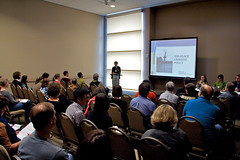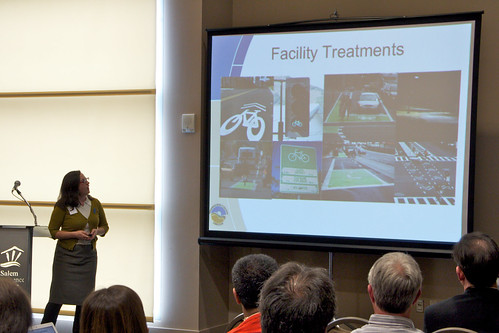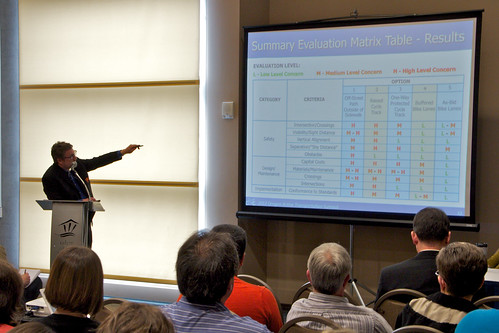
Bicycle Transportation Alliance
was one of the presenters.
(Photos and story by Will Vanlue)
The most interesting (in my opinion) and well-attended session I sat in on at the Oregon Active Transportation Summit focused on the work being done just over the hill from Portland in Washington County.
The session covered a few topics including an overview of two recent road projects and a change in the county’s policy on mid-block crossings (a key policy given the presence of many multi-use paths and suburban/rural arterials).
It also dove into Washington County’s highly anticipated Bicycle Facility Design Toolkit, an official document to help planners and engineers select the appropriate facility for bicycle traffic.
“the last thing people in Washington County need to hear more of is “Portland, Portland, Portland.”
Drusilla Van Hengel, Planning and Programs Manager for Alta Planning & Design, explained the simple three-step process laid out in the toolkit:
- Evaluate a road (the speed and volume of motor vehicles, the age and abilities of people expected to use the road, etc) and select the safest, most protected type of bicycle facility for that type of road.
- Evaluate the technical feasibility of the type of bicycle facility chosen and adjust the design if needed.
- Run through a final yes/no decision chart to confirm the final design is appropriate for the given situation.
So why does Washington County need its own toolkit when there are other design standards (like the NACTO Urban Bikeway Design Guide)?
It’s because most modern design standards focus on solutions for urban environments. While that’s all well and good, Washington County covers a wider range of land use, from urban downtowns to rural farmland and nearly everything in between. With a broad mix of land use in Washington County, engineers need support and guidance on a wider range of design options.
Having a Washington County-specific guide also gives engineers greater confidence when choosing “innovative” (which usually means “safer”) designs for bicycling infrastructure, knowing designs they’re choosing from were identified and approved by other officials in Washington County.
The toolkit isn’t just for engineers and planners, however.
Jessica Horning, Transportation Planner with Kittelson & Associates, explained how, along with planners and engineers, the toolkit is also geared towards developers and citizens.
There are plenty of photos and easy-to-understand charts in the toolkit to help developers better understand county standards and give residents an idea of what to expect when projects are underway in their neighborhood.
Horning also said the toolkit gets Washington County out from under the shadow of neighboring Portland. Transportation is a regional issue in the tri-county area but challenges faced in Washington County are far different from those in Portland’s core. As Horning put it, the last thing people in Washington County need to hear more of is “Portland, Portland, Portland.”
That’s why the toolkit contains lessons from a number of places outside of the Portland-Metro area. Designers of the toolkit drew on knowledge from Minneapolis, Victoria, Vermont, and even Wisconsin to find “best practices” that fit Washington County’s needs.
Since the toolkit contains solutions and decision guides for a wide variety of land use, it could be useful to many other jurisdictions across the United States that have a blend of urban, suburban, and rural neighborhoods.
Adam Argo, who presented the overview of two Washington County road projects and is on the board of the Westside Transportation Alliance, mentioned that this presentation has already been accepted into another transportation planning event in California.
Currently the Toolkit is in it’s final draft phase. You can review the full toolkit (PDF) on Washington County’s website and provide your thoughts and feedback for consideration until April 30th.
— This report from the Oregon Active Transportation Summit was contributed by Will Vanlue. Read more from him on The Prudent Cyclist and check our archives for more Washington County coverage.



